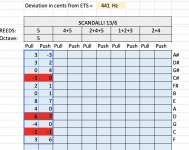chj
Member
My scandalli has a bass register to play only the octave5; those reeds vaxed directly on the bass unit, not on separate reed block. Thus, I can measure that reed alone. Picture shows results. Three reeds are loose marked red, but the question I have is:
The D and E notes are significantly higher in pitch. Is this most likely just reeds out of tune, or could it be some special tuning, e.g. to make chords in the C key sound better, or similar?
I try to minimize pllanned tuning work after waxing (clearly mandatory on at least those 3 reeds).
Am I probably best of tuning everything to ETS442 (the default of this device)?
The D and E notes are significantly higher in pitch. Is this most likely just reeds out of tune, or could it be some special tuning, e.g. to make chords in the C key sound better, or similar?
I try to minimize pllanned tuning work after waxing (clearly mandatory on at least those 3 reeds).
Am I probably best of tuning everything to ETS442 (the default of this device)?

